Shortly before she found out she was pregnant, the father of Maria Carrillo’s baby died unexpectedly. Facing some hard choices, she decided to keep the baby, which resulted in no other option but to move back in with her mother.
Her appendix burst during the pregnancy and Ceasar Carrillo was born prematurely, diagnosed with hydrocephalus from the impact and spent the first month of his life in an incubator. At two months he endured his first head surgery. Ceasar is now 3 years old, suffers seizures regularly and is under the constant and dedicated care of Children’s Hospital Los Angeles.
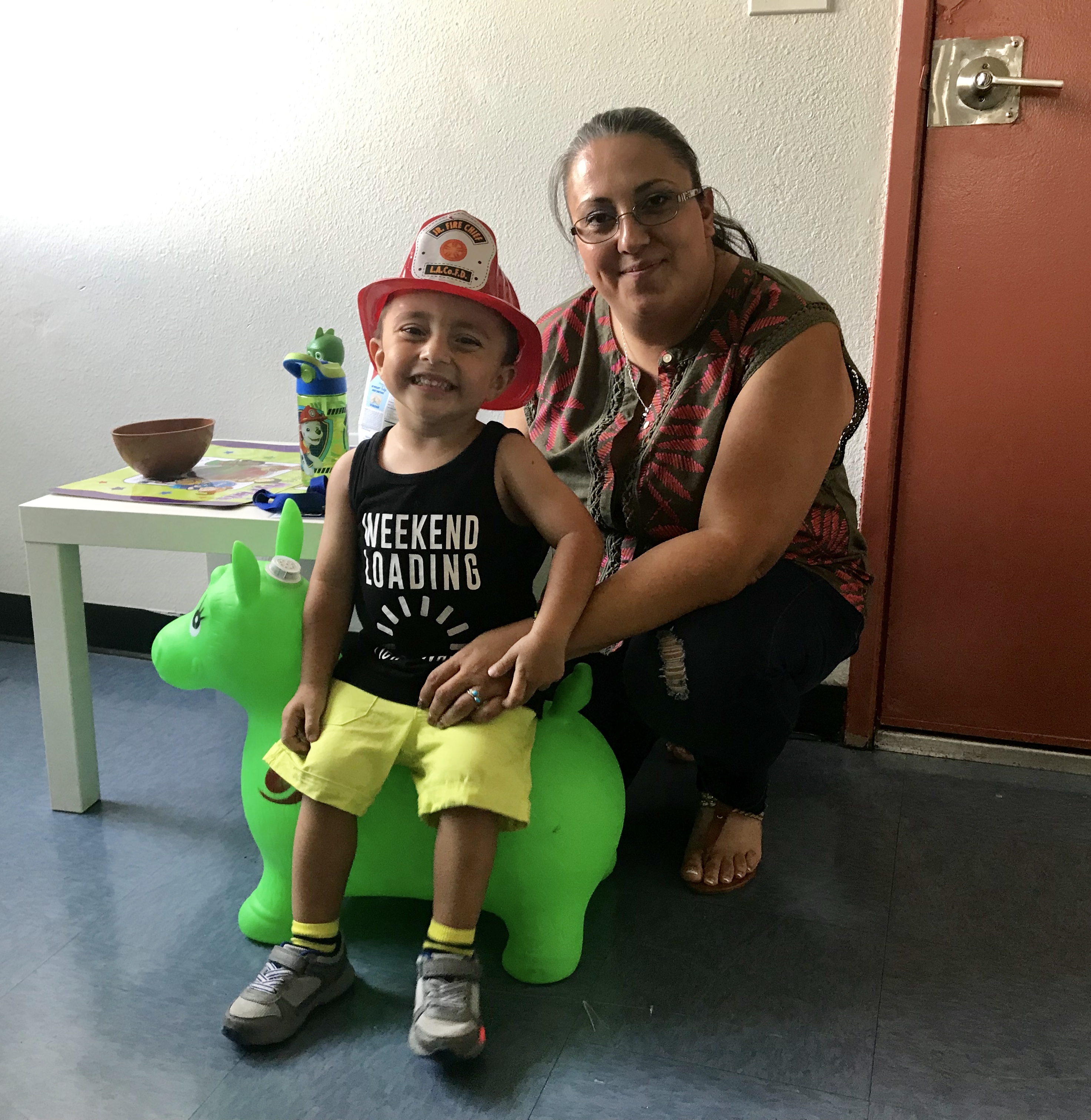
Maria and Ceasar Carrillo. Photo Michele Stueven
While things settled somewhat, the stressful relationship between Carrillo and her mother became increasingly abusive and strained. Her mom was the only support system she had, but it wasn’t really true support. She was doing more damage than good, Carrillo realized. The three of them lived together and Carrillo paid half the rent while she was going to school at Mission College.
She came home everyday to her son crying, saying grandma kept smacking him in the head. Ceasar started getting aggressive. Despite the security of a roof over her head, Carrillo had no other option but to move out.
The single mother rented out a room from close friends in North Hollywood, near where she grew up. It was close to school and Children’s Hospital Los Angeles, Ceasar’s lifeline which provided his regular intensive medical needs at no cost. Before long her friend, a teacher, retired and had to move to Tennessee to live with family on short notice.

Irmas Family Campus, LA Family Housing. Photo Michele Stueven
Carrillo was left with no options. She and Ceasar were on the street, living in her car and at a loss of what to do next. Ceasar had difficulty adjusting to change and some of his medications needed refrigeration — they needed a stable environment. The stress of the situation made the seizures more frequent — he wouldn’t eat, he wouldn’t talk.
“It was hard for me to speak up and reach out for help, I’m a shy person,” Carrillo says from her current home at the Irmas Family Campus at LA Family Housing in North Hollywood, the first completed project to utilize HHH Funds.
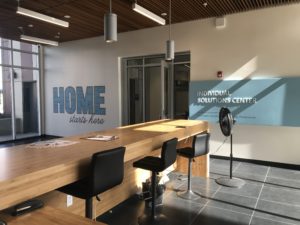
LA Family Housing Solutions Center. Photo Michele Stueven
“I had to learn to reach out and knock on doors and trust people,” she says. “I was afraid of saying anything at first and worried that Child Services would take my son away from me. It was my choice to have him after his father passed away. I could have given him up for adoption. So, I have to be an advocate for him. Even my therapist wondered how I could go to class and focus with everything going on. It’s not easy, but what could I do? I had to keep going.”
The campus, which stands out like the Taj Mahal on a deteriorated section of Lankershim Boulevard near the Burbank Airport, is a model for homeless services. The massive complex is a comprehensive service hub for individuals and families in need of assistance, with bridge housing for 250 individuals and 13 families, 50 units of permanent supportive housing for chronically homeless adults and a community health center. Two resource centers provide a first point of engagement for individuals and families in need of services and housing.
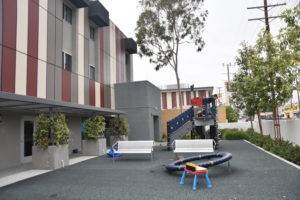
Irmas Family Campus kids area
The south campus has a family solutions center for families experiencing homelessness, where Coordinated Entry System partners — LAUSD and Department of Public Social Services —sit together under one roof.
With a total of 270 employees, $31.8 million came from public funds and $24.4 from private support for the facility, which has family and individual solutions centers, a dining hall, behavioral, mental and other health services, community rooms and courtyards for kids and adults.
“One of the biggest misconceptions people have is that somebody like Maria did something wrong to end up here,” says Velvet de Obaldia, the LA Family Housing diversion specialist who has helped Carrillo navigate what can be a complicated bureaucratic system.
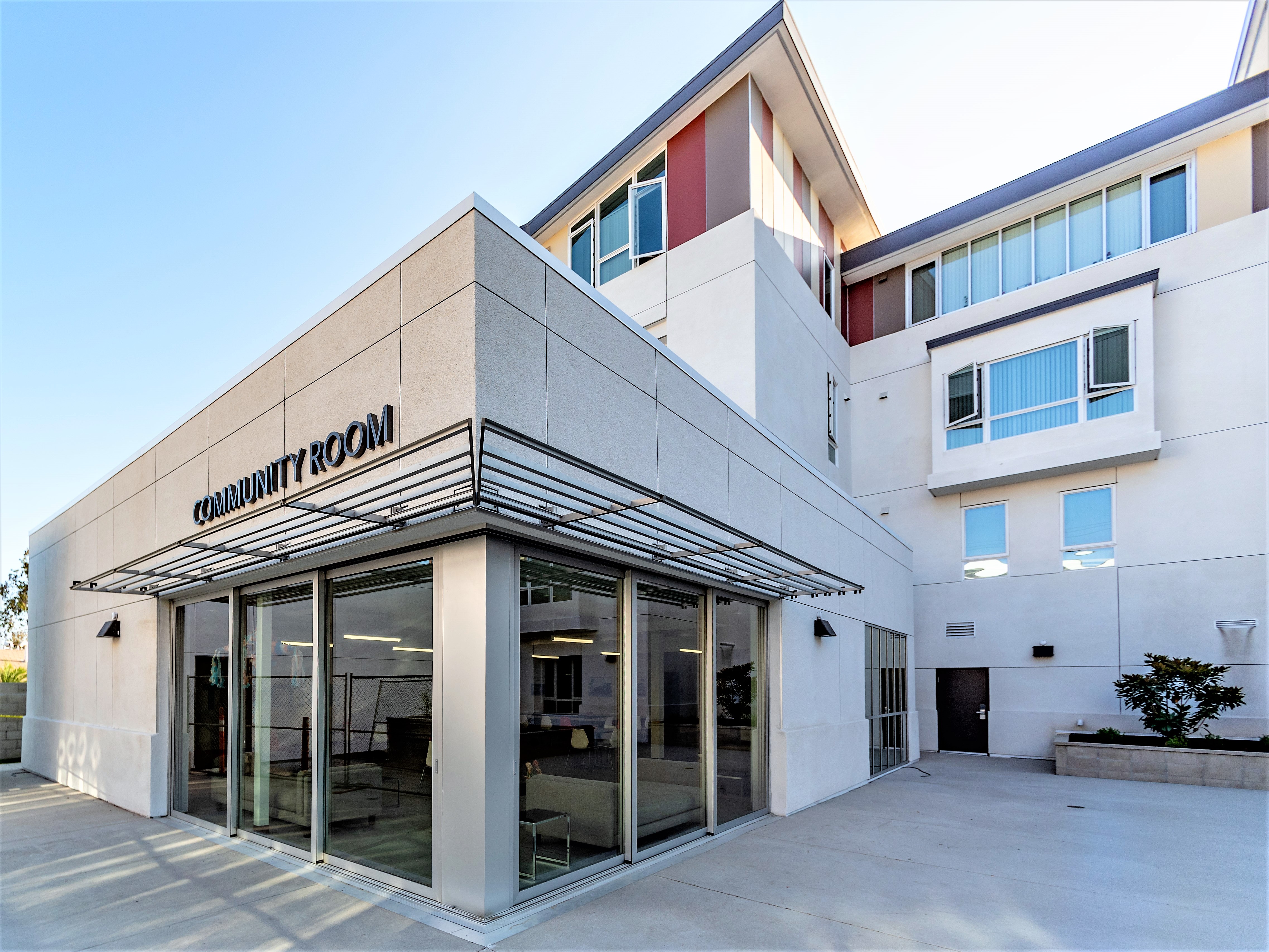
Irmas Family Campus Community Room
“That’s one of the most misunderstood aspects of the housing crisis and housing instability. ‘You must have done something that got you here. This is your fault.’ We have this idea of pulling ourselves up from the bootstraps, which sounds great for those who are stable. But everybody’s story is unique — you’re a single mom and you lose your job, your family moves away, your partner dies, there is illness. The people who walk in our doors were stably housed at one point. It’s embarrassing to ask for help, and you have to divulge your entire story. It’s rarely a choice they have made. It’s not because Maria didn’t work hard enough or try hard enough.”
Still, Maria blamed herself. “I thought it was my fault I became homeless,” she says. “But I’d rather go through this and make sure my son is in a healthy environment. It’s all about safety and security for my child.”
The Department of Social Services offers temporary homeless assistance, which translates into 16 days of eligibility for motel assistance, which can be accessed once a year. It used to be once a lifetime, but now it’s once a year because the housing crisis is so severe. There’s also addition criteria if you’re experiencing domestic violence.

Engage
It was Carrillo’s therapist at the Department of Mental Health who introduced her to LA Family Housing.
“When we first met Maria, we talked about 14 days,” says de Obaldia. “You think about intimate domestic violence, but the domestic violence was from her mother. So, she got the 16, the 14 and an additional 14 after that we stepped in. One of the things we try to do is get our participants connected with the assistance that is available through DPSS. That keeps things consistent, especially with the children and trying to keep them in one location.”
It’s the diversion specialist’s job to advocate participants to the housing team if children have issues with transition and try to keep them in the same hotel in an effort to reduce trauma. Collaboration between partnering agencies is crucial for the success of participants.
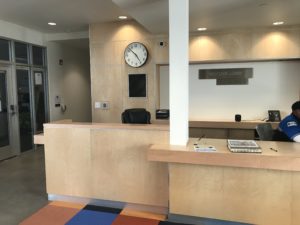
Inside the campus. Photo Michele Stueven
L.A. Family Housing contracts with different hotels, like Motel 6, which are based on availability and can change depending on the families coming in. The reason Angelenos may not see as many homeless families on the street is because they are actually in motels. The family situations stay hidden.
The HHH money funds help with supportive services and employing people to do the work. The money goes into supportive services for participants, like screening for eligibility, housing navigators that help those who are unhoused, and hiring more people to take on increasing caseloads. Measure H funds all services mentioned by de Obaldia, and the Prop. HHH housing bond funds the building and renovation of the property.
LA Housing makes an effort to connect people with family members or other support systems through mediation to get them temporary housing.

LA Family Housing
“If you have family in Georgia, we have funding available to get you back to Georgia,” deObaldia tells L.A. Weekly during a recent tour of the campus. “We had funding to send Maria to Tennessee, but Ceasar’s doctors are here at CHLA. Those funds come from HHH. We try to get people connected.”
And while the campus is an encouraging and functioning model of how to manage the homeless situation in Los Angeles that even a NIMBY could love, so much more needs to be done in terms of space. LA Family Housing has already gone over budget this year, after underestimating the number of families coming in for housing assistance.
“As an agency we buy buildings and we create,” says de Obaldia, who strongly believes that rent control and a moratorium on evictions would help the current crisis.
“We not only have the social service component; we also have the real estate component. There’s that community pushback, and we do our best to communicate with the neighborhood to understand the situation. Buildings like this can actually improve a neighborhood,” she says in terms of rehabilitating and renovating decaying motels and apartments.
With the help of LA Family Housing, Carrillo has been able to secure child care for Ceasar while she finishes her degree in child development. Even when she didn’t know where they would sleep at night, she never stopped going to school. She has four dean’s list certificates for child development because of her good grades during the last turbulent semesters.
And the security and stability of their one-room apartment with bunk beds and kitchenette they’ve been living in since January and a regular routine for Ceasar has resulted in fewer seizures.

Maria and Ceasar Carrillo. Photo Michele Stueven
“You can’t always tell from looking at some people that they’re homeless,” says Carrillo, who remains motivated and resilient.
“I had a friend a month ago say she hated me. She said I seemed so happy and didn’t have any problems. I just laughed and thought — you are so wrong. You have no idea what I am carrying. I told her about everything and she was so sorry.”
L.A. Mayor Eric Garcetti recently announced the addition of new state funds and a $124 million plan to get more homeless off the streets.
“Homelessness is the greatest humanitarian challenge of our time,” the mayor tells L.A. Weekly. “We can only overcome it by investing significant resources in the kind of supportive housing and services that voters funded through Prop. HHH. The Irmas Family Campus at LA Family Housing includes the first HHH-funded project to open its doors, and we are pushing harder than ever to get more housing built across the city.”
Advertising disclosure: We may receive compensation for some of the links in our stories. Thank you for supporting LA Weekly and our advertisers.

